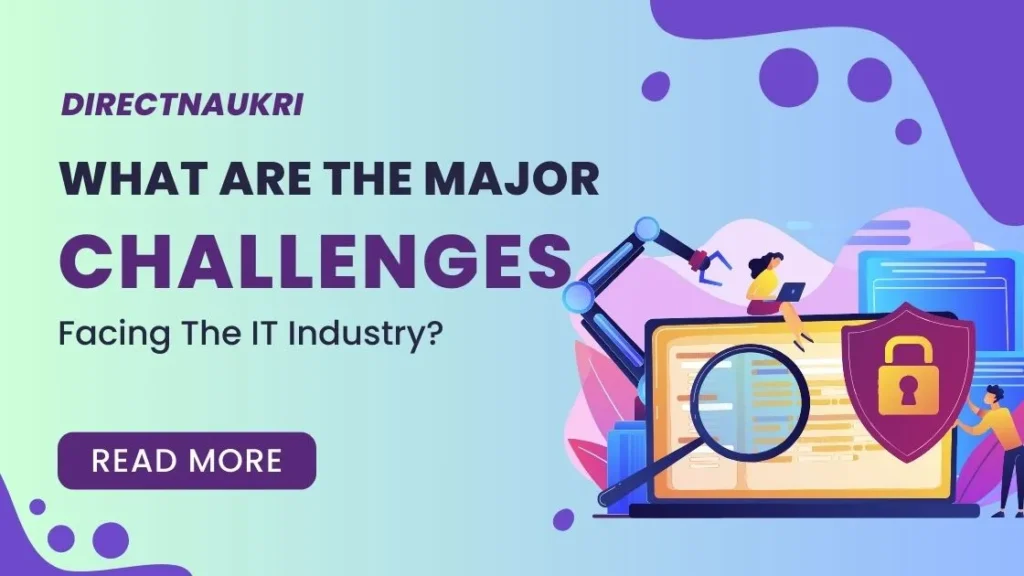The field of Information Technology (IT) has witnessed an exponential growth over the years, revolutionizing the way we live, work, and communicate.
From the rapid development of cutting-edge technologies to the increasing demand for digital solutions, the IT industry is at the forefront of modern advancements.
However, like any other industry, it faces its fair share of challenges. In this blog post, we will explore the major obstacles that the IT industry encounters and discuss potential strategies to overcome them.

Cybersecurity: Protecting Digital Assets
One of the most critical challenges faced by the IT industry is the ever-growing menace of cyber threats. As technology continues to evolve, so does the sophistication of hackers and cybercriminals.
With an alarming increase in the frequency and intensity of cyber attacks, organizations must prioritize cybersecurity to protect their digital assets and sensitive information.
To combat this challenge, the IT industry must invest in robust cybersecurity measures, including firewalls, encryption, and continuous monitoring.
Additionally, organizations should implement comprehensive employee training programs to educate staff on best practices for data security, such as strong password management and detecting phishing attempts.
Talent Shortage: Finding Skilled Professionals
In an industry driven by technological innovation, finding skilled IT professionals with the necessary expertise and knowledge is a significant challenge.
The demand for specialized skills often surpasses the supply, leading to a talent shortage in the IT industry.
To address this issue, companies can take proactive measures such as partnering with educational institutions to develop IT-focused curriculum, offering competitive compensation packages to attract top talent, and providing opportunities for continuous learning and professional development.
Furthermore, organizations can implement mentorship programs to bridge the skills gap and retain valuable employees.
Legacy Systems: Modernizing Outdated Infrastructure
Many organizations still rely on outdated legacy systems that were built decades ago. These systems often lack compatibility with modern technologies, hindering innovation and efficiency.
Upgrading or migrating from legacy systems can be a complex and costly undertaking, which poses a challenge for the IT industry.
To overcome this obstacle, organizations should prioritize modernization efforts, gradually phasing out legacy systems and adopting more agile, scalable, and cloud-based solutions.
This transition not only enhances operational efficiency but also enables organizations to leverage emerging technologies such as artificial intelligence and machine learning.
Also See: What Are The Top Challenges Facing The Banking Industry?
Data Privacy: Ensuring Consumer Trust
With the proliferation of digital services and the increasing amount of personal data being collected, ensuring data privacy has become a major concern for the IT industry.
Organizations must navigate stringent data protection regulations and demonstrate their commitment to safeguarding customer information.
To address this challenge, organizations should adopt privacy-by-design principles, embedding privacy measures into their systems and processes from the outset.
Implementing strong data encryption protocols, conducting regular privacy audits, and providing transparent privacy policies are key steps toward building consumer trust and complying with data protection regulations.
Cloud Computing: Managing Scalability and Security
Cloud computing has revolutionized the IT industry by offering scalable and cost-effective solutions. However, managing the scalability and security of cloud environments presents unique challenges.
Organizations must ensure that their cloud infrastructure can handle spikes in demand while maintaining the highest level of security.
To tackle this challenge, organizations should implement robust cloud management strategies, leveraging automated scaling and monitoring tools.
Additionally, regular vulnerability assessments and penetration testing can help identify and address potential security gaps within the cloud infrastructure.
Conclusion
The IT industry is a dynamic and ever-evolving field, driven by technological innovations and the demand for digital transformation.
However, it is not without its challenges. Cybersecurity threats, talent shortages, legacy systems, data privacy concerns, and cloud management complexities are some of the major obstacles faced by the IT industry today.
Addressing these challenges requires a proactive and strategic approach. By investing in robust cybersecurity measures, bridging the talent gap through partnerships and professional development programs, modernizing outdated infrastructure, prioritizing data privacy, and implementing effective cloud management strategies, the IT industry can navigate these hurdles and continue driving innovation.
As the industry continues to evolve, it is essential for organizations and professionals to stay updated with the latest trends, industry best practices, and emerging technologies.
By embracing a forward-thinking mindset and continuously adapting to change, the IT industry can overcome challenges and flourish in this digital era.
FAQs:
What are the major challenges facing the IT industry?
The IT industry grapples with numerous challenges, including cybersecurity threats, talent shortages, rapid technological advancements, and the need for constant innovation.
How are cybersecurity threats affecting the IT industry?
Cybersecurity threats pose a significant risk to businesses and organizations, demanding constant vigilance and investment in protective measures to safeguard sensitive data and systems.
Why is there a talent shortage in the IT industry?
The rapid expansion of the IT sector has led to a shortage of skilled professionals. Finding and retaining qualified individuals in areas like cybersecurity, data science, and software development can be challenging.
How does the fast pace of technological change impact the IT industry?
The IT industry must keep up with rapid technological advancements, which can require substantial investments in training and infrastructure to stay competitive and meet evolving client needs.
Why is innovation crucial for the IT sector?
Continuous innovation is vital in the IT industry to stay ahead of the curve, deliver cutting-edge solutions, and adapt to changing market demands and emerging technologies.







